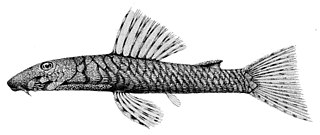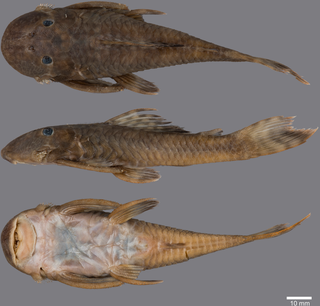Otothyropsis biamnicus is a species of catfish in the family Loricariidae. It is native to South America, where it occurs in tributaries of the Iguazu River and the Tibagi River, which are both in the Paraná River basin of Brazil. It is noted to be commensal with midge larvae of the family Chironomidae, which attach to the gill openings or more rarely the cleithrum of the fish. It reaches 4 cm SL. The specific epithet of this species, biamnicus, roughly translates to "inhabitant of two rivers", which refers to the species' distribution in tributaries of two different rivers.
Ancistrus parecis is a species of catfish in the family Loricariidae. It is native to South America, where it occurs in the Tapajós River basin in Brazil. Its specific epithet refers to the Parecis Plateau, where the type specimen was collected. The species reaches 6 cm SL.
Ancistrus heterorhynchus is a species of catfish in the family Loricariidae. It is native to South America, where it occurs in the Inambari River basin, which is part of the Madre de Dios River drainage in Peru. The species reaches 6.3 cm SL and is known to inhabit high-altitude areas.

Ancistrus marcapatae is a species of catfish in the family Loricariidae. It is native to South America, where it occurs in the Inambari River basin, which is part of the Madeira River drainage in Peru. The species reaches 12.4 cm in total length.
Ancistrus reisi is a species of catfish in the family Loricariidae. It is a freshwater fish native to South America, where it is known to occur in small rivers in the state of Tocantins in Brazil. The species reaches 6.1 cm SL and is distinguished from most members of the genus by the absence of an adipose fin, which for this species is replaced by a series of unpaired platelets that form a low crest.
Ancistrus tolima is a species of catfish in the family Loricariidae. It is native to South America, where it occurs in the Magdalena River drainage, which is part of the Prado River basin in Colombia. The species reaches 7.7 cm SL. Its specific epithet is a reference to Colombia's Tolima Department, which contains the type locality of the species.
Ancistrus vericaucanus is a species of catfish in the family Loricariidae. It is native to South America, where it occurs in the basin of the Cauca River, which is a tributary of the Magdalena River, in Colombia. It reaches 7.2 cm SL. Its congener Ancistrus caucanus was once thought to inhabit the Cauca River basin and was named after the river itself, but it was determined in 2013 that A. caucanus was not actually native to the Cauca. The specific epithet of A. vericaucanus means "true caucanus", in reference to the misleading name of A. caucanus.
Chaetostoma niveum is a species of catfish in the family Loricariidae. It is native to South America, where it occurs in the Jurubidá River basin in the Chocó Department in Colombia. The species reaches 9.1 cm SL.
Peckoltia capitulata is a species of catfish in the family Loricariidae. It is native to South America, where it occurs in the Approuague River in French Guiana. It was initially collected from an area of the river with a swift, strong current that was noted to be unusually turbid at the time of collection due to illegal gold mining in the area. The species reaches 7.6 cm SL. Its specific epithet, capitulata, is derived from Latin and reportedly refers to the characteristically small head of the species.
Peckoltia lineola is a species of catfish in the family Loricariidae. It is native to South America, where it occurs in the basins of the Ventuari River in Venezuela and the Inírida River in Colombia. The species reaches 9.7 cm SL and is typically found in rocky riffles. Its specific epithet, lineola, derives from a Latin word meaning "line", referring to the lines present on the species' compound pterotic.
Peckoltia simulata is a species of catfish in the family Loricariidae. It is native to South America, where it occurs in the Oyapock River in French Guiana. The species is typically found in small forested creeks with a substrate of gravel or sand, as well as rocks, leaves, and wood. It has been collected alongside a variety of other species, including other loricariids belonging to the genera Ancistrus, Farlowella, Guyanancistrus, Otocinclus, and Rineloricaria.
'Pseudancistrus' megacephalus is a species of catfish in the family Loricariidae. It is of uncertain and disputed classification.
Hypostomus rhantos is a species of catfish in the family Loricariidae. It is native to South America, where it occurs in the Ventuari River as well as the upper Orinoco, ranging from above Puerto Ayacucho to the Casiquiare in Venezuela. The species reaches 19.6 cm SL. Its specific epithet, rhantos, derives from a Greek word meaning "speckled" and refers to the species' pattern of small spots.
Hypostomus kuarup is a species of catfish in the family Loricariidae. It is native to South America, where it occurs in the Culuene River in the Xingu River basin in the state of Mato Grosso in Brazil. It is typically found in rapids within its range, although the type locality of the species has subsequently dried out due to the construction of a nearby dam. Despite this, it is still known to inhabit rapids above and below the dammed area, as well as a fish ladder built near the type locality. It is sympatric with its congener Hypostomus faveolus.
Hypostomus macushi is a species of catfish in the family Loricariidae. It is native to South America, where it occurs in the Essequibo River, the Ireng River, the Rupununi, and the Takutu River along the border of Brazil and Guyana. It is typically seen near dead, submerged wood in areas with moderate to fast-flowing water. The species reaches 17 cm SL and is believed to be a facultative air-breather. Its specific epithet, macushi, refers to the Macushi people of the Rupununi region who collected specimens of the species and are stated to have provided the authors of its description, Jonathan W. Armbruster and Lesley S. de Souza, with hospitality while in Guyana.

Guyanancistrus brevispinis is a species of catfish in the family Loricariidae. It is a freshwater fish native to South America, where it occurs in the Atlantic coastal drainages of the Guianas, ranging from the Nickerie River basin to the Oyapock basin in French Guiana and Suriname. It has also been reported from Guyana, but this is believed to be a misidentification. The species is considered the most common and abundant member of the genus Guyanancistrus, occurring in rocky streams with flowing water, especially in the vicinity of plunging waters. It is known to coexist with members of the genus Lithoxus in small forested creeks as well as rapids. The species reaches 14.2 cm in standard length.

Guyanancistrus brownsbergensis is a species of catfish in the family Loricariidae. It is native to South America, where it occurs in the upper Kumbu Creek, which is part of the Saramacca River basin, in Brownsberg Nature Park in the Brownsberg Mountains in Suriname. The type locality of the species is a small mountain stream with a width of 2.5 to 3.7 m, a depth of 28 to 50 cm, a temperature of 23.1 to 23.2 °C, an oxygen concentration of 7.08 to 7.72 g/mL, an oxygen saturation of 93% to 96%, a pH of 7 to 7.5, a conductivity of 30.8 to 31.6 μS/cm, and a current strength of 0.29 to 0.56 m/s. The stream has clear water and a substrate composed of sand, gravel, pebbles, bedrock, and boulders, and overhanging vegetation, leaf litter, and woody debris are present. The species reaches 6.4 cm in standard length. It is known that the habitat of the species is threatened by illegal gold mining.

Guyanancistrus megastictus is a species of catfish in the family Loricariidae. It is native to South America, where it occurs in a forested tributary of the upper Maroni basin in French Guiana, near the Mitaraka Massif, which is a prominent massif in the area. The species reaches 6.3 cm in standard length. Its specific epithet, megastictus, is derived from Ancient Greek and refers to its large spots.

Guyanancistrus teretirostris is a species of catfish in the family Loricariidae. It is a freshwater fish native to South America, where it occurs in the upper Paru de Oeste River in Brazil. The species reaches 9.8 cm in standard length. Its specific epithet, teretirostris, is derived from Latin and refers to the rounded shape of the species' snout.
Harttiella longicauda is a species of catfish in the family Loricariidae. It is native to South America, where it occurs in mountainous areas in the vicinity of Trinité Massif and Balenfois Massif in northern French Guiana. The species reaches 5.2 cm in standard length. It is known to occur alongside the species Characidium fasciadorsale, Krobia itanyi, Lithoxus planquettei, and Rhamdia quelen, as well as members of the genera Ancistrus, Guyanancistrus, Melanocharacidium, and Rineloricaria. The species was described in 2012 as part of a taxonomic review of members of the loricariid tribe Harttiini native to the Guianas.






